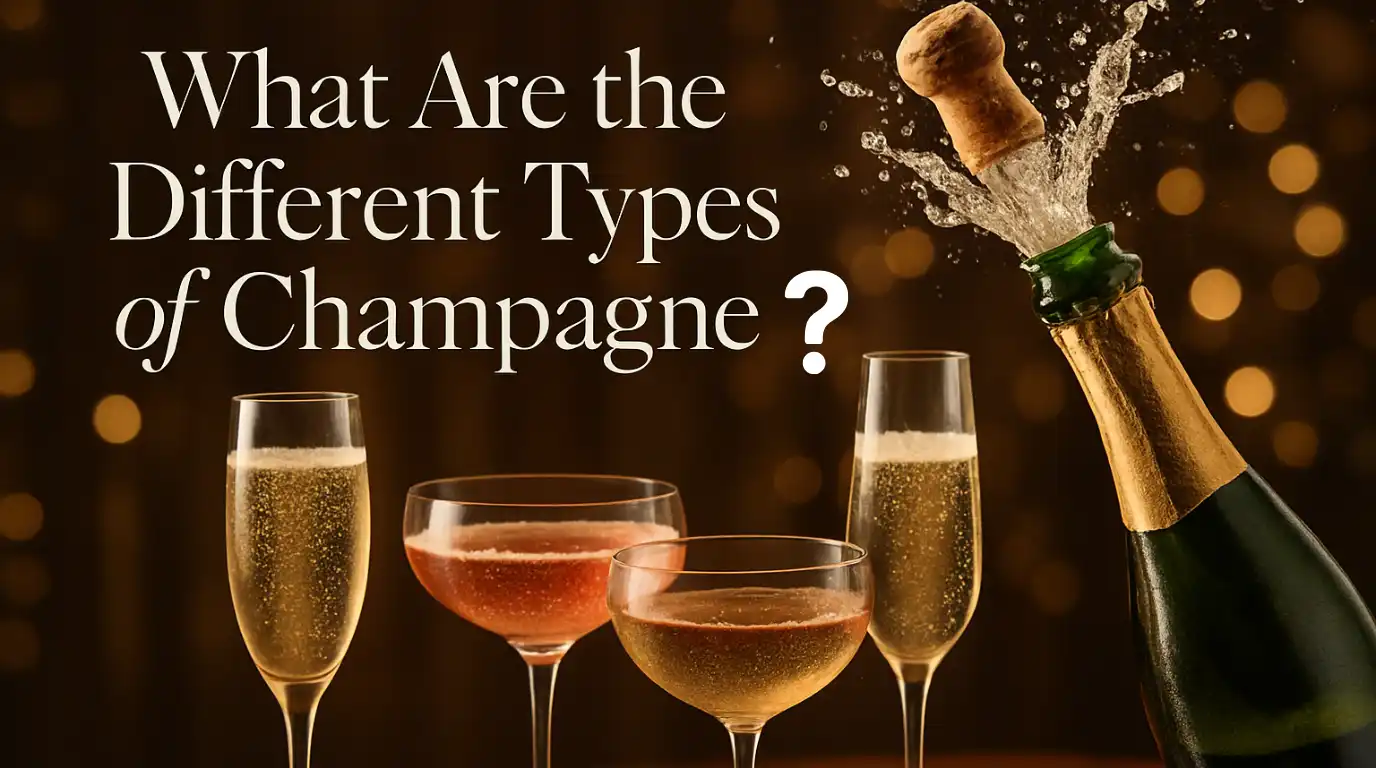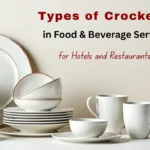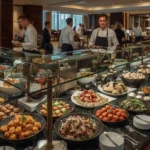Champagne is one of the most celebrated wines in the world. But did you know that not every sparkling wine is Champagne?
By law, only wines produced in the Champagne region of northeastern France—under strict regulations—can carry the name “Champagne.“ This protected status ensures authenticity, quality, and tradition.
What truly sets Champagne apart is its unique method of production, called the Méthode Champenoise (or Traditional Method). This involves a second fermentation inside the bottle, creating its signature fine bubbles, complexity, and ageing potential. In contrast, other sparkling wines like Prosecco use simpler methods with fermentation in large tanks.
Champagne is usually made from a blend of three key grape varieties:
- Chardonnay (white)
- Pinot Noir (black)
- Meunier (black)
Together, these grapes—combined with the region’s cool climate, chalky soils, and strict winemaking rules—give Champagne its freshness, elegance, and ability to age beautifully.
How Is Champagne Classified?
Champagne is not one-size-fits-all. It is classified in several important ways based on:
- Grape Composition – What grapes are used? (e.g., Blanc de Blancs, Blanc de Noirs, Rosé)
- Sweetness Level – How much sugar is added? (e.g., Brut, Demi-Sec)
- Vintage – Is it made from a single harvest year or a blend of years?
- Prestige & Style – Is it a special cuvée or a house blend?
- Producer Type – Is it made by a grower or a big Champagne house?
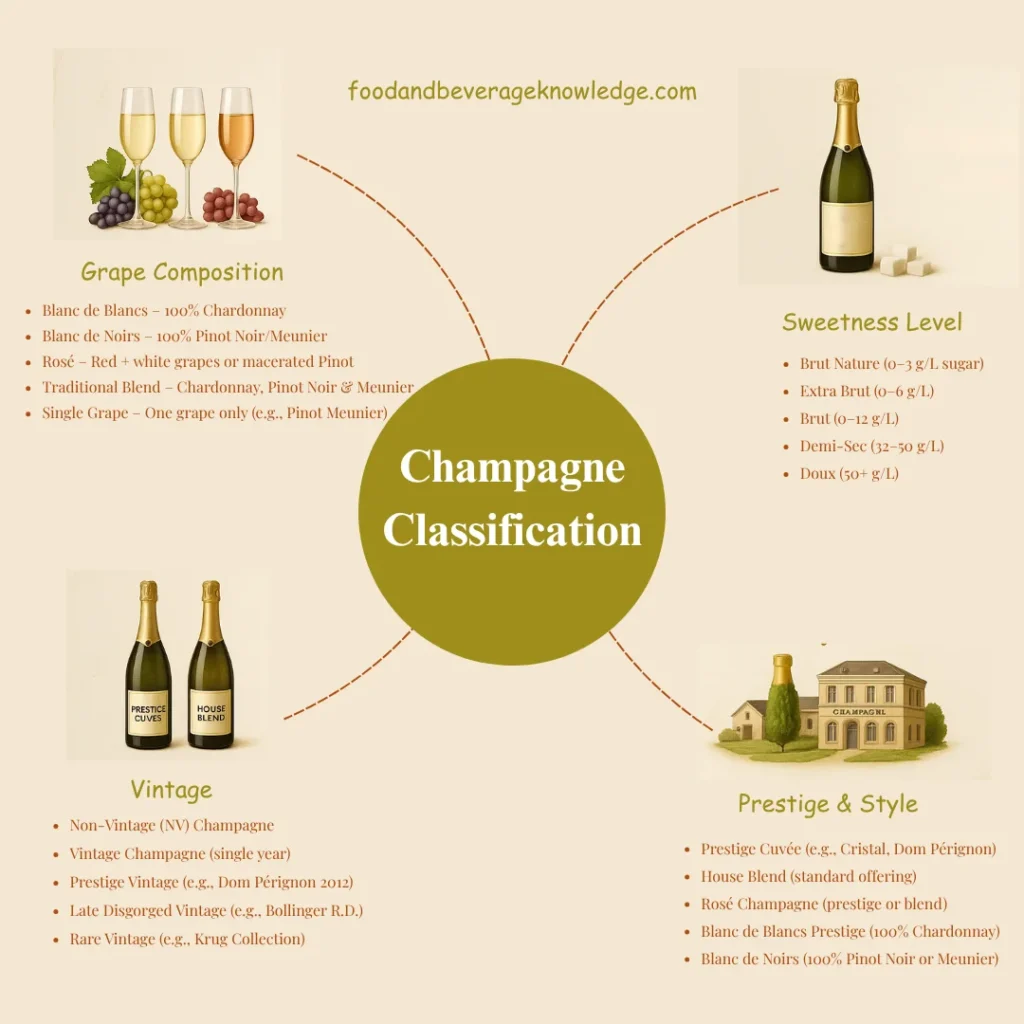
In the following sections, we’ll explore each type in detail, so you can understand, recommend, and serve Champagne with confidence—an essential skill tied closely to the responsibilities of waiters and waitresses in delivering exceptional guest experiences.
Classification by Grape Composition
Understanding the grapes used in a Champagne helps you know what to expect in its taste, texture, and aroma. For any sommelier or F&B professional, this is a powerful tool—not only for explaining options to guests but also for making confident pairing suggestions.
In the context of food and beverage service, this knowledge enhances the ability to curate memorable dining experiences. Different types of Champagne are made using different grape varieties, and each type has its own style and personality.
1. Blanc de Blancs: The Elegance of 100% White Grapes
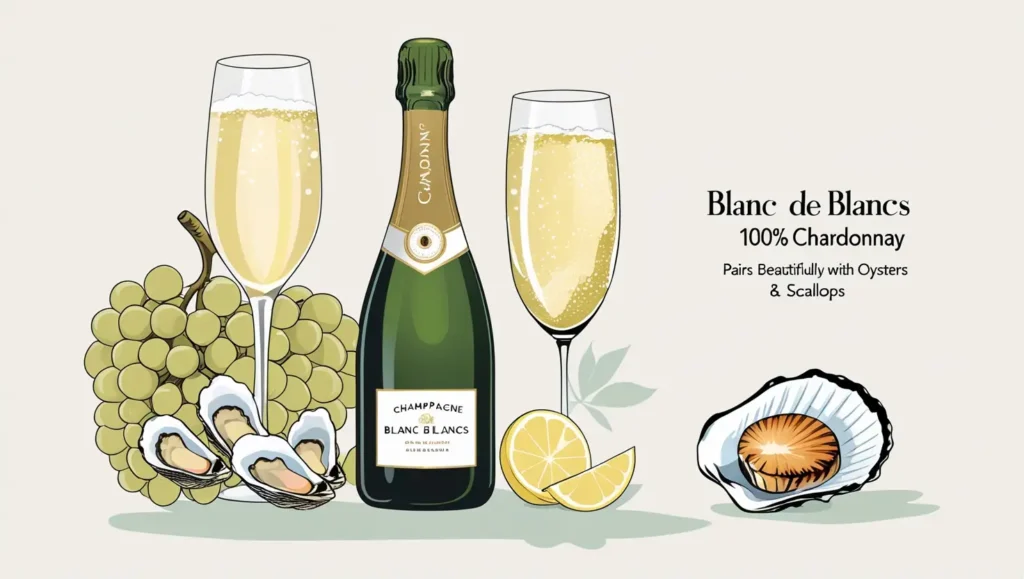
Blanc de Blancs means “white from whites.” This type of Champagne is made only from white grapes, and in almost all cases, that means 100% Chardonnay.
While other white grape varieties (like Arbane, Petit Meslier, and Pinot Blanc) are legally allowed, they are very rare and used only in tiny amounts.
Tasting Profile: Blanc de Blancs is known for its light body, fresh acidity, and elegant character. These Champagnes are usually crisp and bright, with a clean and refreshing finish. One key trait is their minerality, which comes from the chalky limestone soils of the famous Côte des Blancs area.
Aromas: On the nose, you can expect:
- White flowers like hawthorn and jasmine
- Citrus fruits such as lemon and grapefruit
- Green orchard fruits like apples and pears
As Blanc de Blancs ages, it can develop creamy textures and more complex aromas like:
- Brioche
- Toasted almonds
- Honey
Service Insight: Blanc de Blancs is ideal as an aperitif because of its refreshing style and bright acidity. It’s also perfect for pairing with light and delicate foods, especially:
- Raw oysters
- Scallops
- White fish
This Champagne is a popular choice for elegant occasions and summer service.
2. Blanc de Noirs: The Power and Structure of Black Grapes
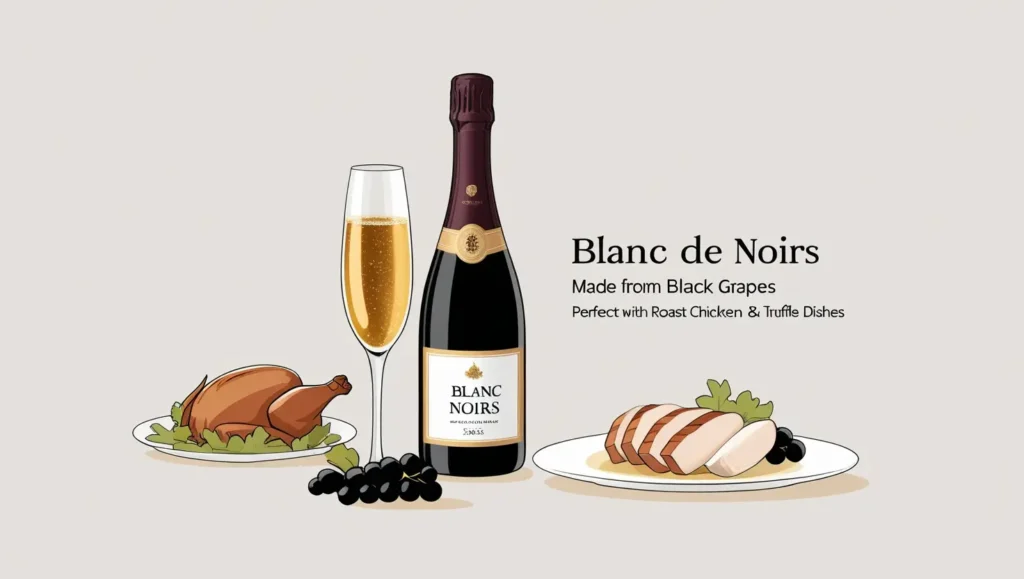
Blanc de Noirs means “white from blacks.” This Champagne is made only from black-skinned grapes—either 100% Pinot Noir, 100% Meunier, or a blend of both.
How It’s Made:
Making a white wine from red or black grapes takes special skill. Winemakers have to press the grapes very gently and quickly to extract the clear juice without picking up color or tannins from the skins. This method keeps the wine white, even though the grapes are dark.
Tasting Profile: Blanc de Noirs is the opposite of Blanc de Blancs in many ways. It’s usually:
- Full-bodied
- Richer and rounder
- More structured and powerful
This style often shows vinosity, which means it feels more like a full-bodied still wine. It gives warmth and depth on the palate.
Aromas: You’ll notice aromas of:
- Yellow fruits like peach and plum
- Red berries like raspberry and strawberry
- Sometimes citrus, such as mandarin
With age, Blanc de Noirs can develop deep, earthy notes like:
- Coffee
- Cocoa
- Leather
- Dried fruits
Service Insight: This style is excellent with richer, more flavorful dishes, including:
- Roast chicken or turkey
- Suckling pig
- Game meats
- Mushroom or truffle-based dishes
Blanc de Noirs works well in cooler seasons or with heavier menus.
For a deeper dive into the differences between Blanc de Noirs and Blanc de Blancs, you can read this detailed guide from Decanter: Blanc de Noirs vs. Blanc de Blancs – Decanter.
3. Rosé Champagne: The Art of Colour and Complexity
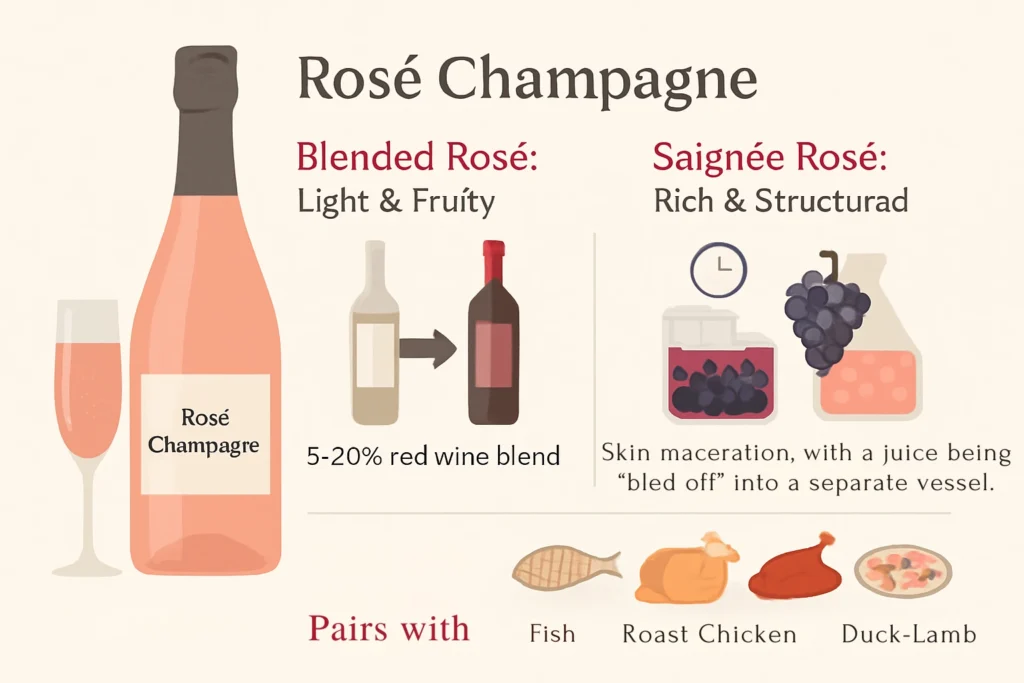
Rosé Champagne stands out for both its appearance and its taste. Champagne is the only French wine region (AOC) where it’s legal to make rosé by blending red and white wine together.
There are two main ways to make Rosé Champagne:
1. Rosé d’Assemblage (Blended Rosé):
This is the most common method. It involves:
Adding 5% to 20% of still red wine (Pinot Noir or Meunier) to a white base wine before the second fermentation.
This gives the winemaker control over the final colour and flavour, and ensures consistency from year to year. These rosés tend to be light in colour and elegant in style.
2. Rosé de Saignée (Macerated Rosé):
Saignbée means “to bleed.” In this method:
- Black grapes are allowed to soak with their skins for 8 to 36 hours.
- This allows colour and flavour to extract naturally.
- The juice is then “bled off” and fermented.
This style is less common but produces deeper colour, richer flavour, and more structure. It is often considered more wine-like than blended rosés.
Tasting Profile & Service Insight:
- Blended rosés are light and fruity—great for appetisers, grilled fish, or roast chicken.
- Saignée rosés are more intense and go well with duck, lamb, or even mildly spicy Asian dishes.
Rosé Champagne is very versatile—it can be served all year round and suits many menus.
4. Cuvée: A Term with Many Meanings
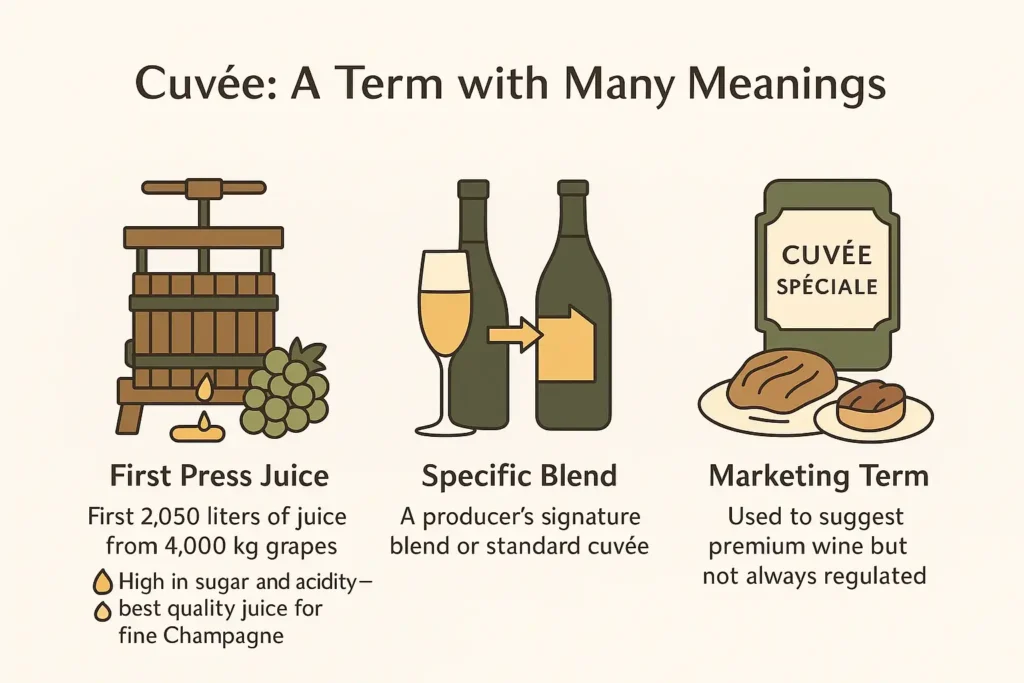
The word “cuvée” is common on Champagne labels, but it can mean different things. This can confuse guests and even professionals, so it’s important to understand what it really refers to.
Meaning 1: The First Press Juice
- In winemaking, “cuvée” refers to the first 2,050 litres of juice from a standard 4,000 kg grape press.
- This first press is high in sugar and acidity, making it the highest quality juice for fine Champagne.
- The juice that comes after, called the taille, is lower in quality and usually not used in prestige cuvées.
Meaning 2: A Specific Blend
- In general wine terms, “cuvée” may just mean a specific blend created by a producer.
- For example, a Champagne house’s standard non-vintage brut is usually referred to as its signature cuvée.
Meaning 3: A Marketing Term
- Many labels use terms like “Cuvée Spéciale” or simply “Cuvée” to suggest a premium wine.
- However, this use is not regulated, and doesn’t always guarantee better quality.
- The most meaningful use is Prestige Cuvée or Tête de Cuvée, which refers to a house’s top-tier wine, covered later in Section 5.
To explore the broader meanings and uses of the term “cuvée” in winemaking, refer to the detailed explanation on Wikipedia: Cuvée.
This Champagne style falls under the broader category of alcoholic beverages, which are important to understand in any beverage program. Learn more about these categories in our guide on the classification and types of beverages.
Champagne Classification by Sweetness Level (Dosage)
In Champagne production, dosage refers to the small amount of sugar (mixed with wine) that is added after ageing and disgorgement. This final step helps balance Champagne’s naturally high acidity and defines the wine’s sweetness level.
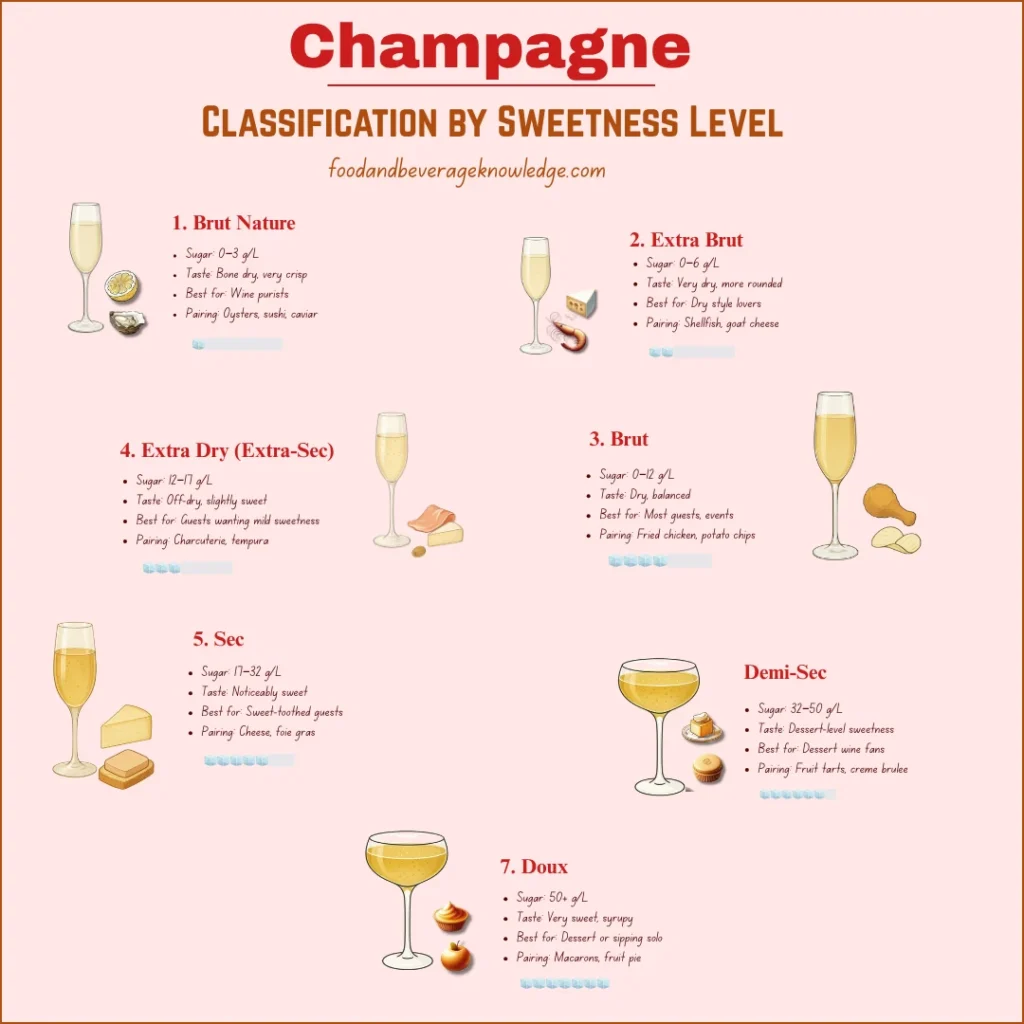
Why Sweetness Level Matters in Service
- Always match the sweetness in wine to the food:
Dry Champagne with sweet desserts will taste bitter or sour. - Use sweeter styles to balance:
- Spicy food (Indian, Thai)
- Rich desserts
- Savoury-sweet dishes like foie gras
- Educate guests:
Many people assume “Extra Dry” is drier than “Brut,” but it’s actually sweeter. Explaining this shows professionalism and builds guest trust.
Champagnes are officially classified into seven sweetness categories, based on how much sugar remains in the wine after dosage. Here’s a breakdown from driest to sweetest:
1. Brut Nature (also known as Pas Dosé or Dosage Zéro)
This is Champagne in its most pure and unadulterated form, with no sugar added during dosage and only 0–3 g/L of residual sugar. It’s bone-dry, with high acidity and intense minerality, making it a favourite for wine purists.
- Sugar content: 0–3 g/L
- Taste: Bone dry, crisp, and very sharp
- Character: No sugar is added. This is the purest expression of the grape and terroir.
- Best for: Wine connoisseurs who enjoy very dry styles
- Food pairing: Oysters, sushi, sashimi, caviar, raw seafood, tinned fish
2. Extra Brut
A step up in roundness from Brut Nature, Extra Brut contains 0–6 g/L of sugar, preserving a very dry profile while adding a touch more softness. It delivers precise structure with subtle fruit and mineral complexity.
- Sugar content: 0–6 g/L
- Taste: Very dry, but slightly more rounded than Brut Nature
- Character: Lean, mineral, clean style
- Best for: Those who enjoy dryness with subtle complexity
- Food pairing: Shellfish, aperitifs, goat cheese, light fish, salty starters
3. Brut
Brut is by far the most popular and versatile Champagne style, with 0–12 g/L of sugar. While still dry, this small amount of sweetness balances the natural acidity, creating a harmonious, rounded taste.
- Sugar content: 0–12 g/L
- Taste: Dry and crisp, but well-balanced
- Character: The most popular Champagne style worldwide—classic, versatile
- Best for: General guests and events
- Food pairing: Fried chicken, potato chips, soft cheeses, roast poultry, most appetisers
4. Extra Dry (also called Extra-Sec)
Despite the misleading name, Extra Dry is actually sweeter than Brut, with 12–17 g/L of sugar. It features an appealing off-dry character, showcasing soft fruitiness and floral tones. This style is great for guests who enjoy a little sweetness without overwhelming sugar.
- Sugar content: 12–17 g/L
- Taste: Off-dry, slightly sweet
- Character: Fruity, approachable, and soft
- Best for: Guests who prefer a hint of sweetness
- Food pairing: Charcuterie, mild spice dishes (Thai, Japanese), soft cheese, tempura
5. Sec
With 17–32 g/L of sugar, Sec Champagne is clearly sweet on the palate, yet still retains Champagne’s natural acidity for balance. The rounded texture and richer mouthfeel make it a fitting choice for cheese courses, foie gras, or light desserts.
- Sugar content: 17–32 g/L
- Taste: Noticeably sweet
- Character: Rounder, fuller, with obvious sugar presence
- Best for: Guests with a sweet tooth, dessert lovers
- Food pairing: Cheese courses, savoury-sweet pastries, foie gras, tarts
6. Demi-Sec
Demi-Sec contains 32–50 g/L of sugar and delivers a distinctly sweet experience. Its luscious texture and bright fruit character make it an excellent dessert wine, pairing beautifully with fruit tarts, pâtisserie, and crème brûlée.
- Sugar content: 32–50 g/L
- Taste: Clearly sweet, dessert-style
- Character: Rich, smooth, creamy
- Best for: Dessert service or guests new to Champagne
- Food pairing: Crème brûlée, fruit tarts, blue cheese, chocolate mousse, foie gras
7. Doux
The sweetest Champagne classification, Doux, contains over 50 g/L of sugar. Once the dominant style in the 1800s, Doux is now rare, appreciated mainly by those seeking a nostalgic or dessert-forward experience.
- Sugar content: 50+ g/L
- Taste: Very sweet, syrupy, luxurious
- Character: Once popular in the 19th century, now quite rare
- Best for: Sweet wine enthusiasts or as a dessert on its own
- Food pairing: Macarons, cakes, fruit pies, or sipped alone after a meal
Vintage vs. Non-Vintage — How Champagne Is Classified by Year and Blend
When it comes to classifying Champagne, one of the key distinctions is between Non-Vintage (NV) and Vintage. These two styles represent different winemaking goals: one aims for consistency, the other celebrates the uniqueness of a single year.
Non-Vintage Champagne (NV): Consistency in Every Bottle
Over 90% of all Champagne sold is Non-Vintage. NV Champagne is made by blending wines from multiple harvests—usually the most recent year’s wine mixed with older reserve wines stored by the Champagne house.
This blending process helps winemakers:
- Balance differences in weather and grape quality from year to year
- Maintain a consistent “house style”, so every bottle tastes familiar and reliable
Ageing Requirements:
- Minimum 15 months total ageing
- At least 12 months on lees (dead yeast cells that add flavour and texture)
- Many houses age NV Champagne for 2 to 3 years for better complexity
NV Champagnes are typically meant to be enjoyed young and fresh, offering bright, approachable flavours perfect for casual celebrations.
Vintage Champagne (Millésime): A Snapshot of an Exceptional Year
Vintage Champagne is crafted from grapes harvested in a single year, which is clearly shown on the label. A Champagne house will only produce a vintage when the harvest is considered exceptional in both quality and character.
Since vintages aren’t declared every year, these wines are:
- Less common and more exclusive
- Designed to express the unique weather and terroir of that vintage
- Often made from the house’s best grapes
Ageing Requirements:
- Must be aged at least 3 years, but many producers age for 4 to 10 years or more
- Extended lees ageing adds deeper complexity, structure, and ageing potential
Vintage Champagnes are richer, more complex, and better suited for ageing. Their higher price reflects their rarity, longer production time, and the superior quality of the grapes used.
To discover premium Vintage Champagnes or explore more about their exclusivity and aging, visit Champagne & Gifts – Vintage Champagne.
Prestige Cuvée — The Highest Class of Champagne
As part of classifying Champagne, Prestige Cuvée (also called Tête de Cuvée) represents the top tier. These are the most exclusive, luxurious, and refined wines a Champagne house can offer.
What Is a Prestige Cuvée?
A Prestige Cuvée is the flagship Champagne of a producer. It reflects the highest level of craftsmanship and quality. While often made as vintage Champagnes, they are not always limited to a single year.
Key Characteristics:
- Made from the best grapes, often from Grand Cru vineyards
- Uses only the first press juice (cuvée) — the most delicate and pure part
- Aged for a long time on lees — typically 6 to 10 years, sometimes much longer
- Designed for complexity, elegance, and ageing potential
Because of the premium ingredients and extensive ageing, Prestige Cuvées are the most expensive and celebrated wines from each house.
Examples of Prestige Cuvées:
To better understand this class, here are some iconic Prestige Cuvées:
1. Dom Pérignon (Moët & Chandon)
- Always a vintage Champagne
- Blend of Chardonnay and Pinot Noir
- Known for its precision, acidity, and signature toasty, smoky notes
2. Cristal (Louis Roederer)
- First made in 1876 for the Tsar of Russia
- Bottled in clear glass (Cristal)
- Celebrated for its purity, minerality, and incredible ageing capacity
3. Krug Grande Cuvée
- A rare example of a non-vintage Prestige Cuvée
- Made from over 120 wines from 10+ vintages
- Aged in oak, known for its rich, nutty, layered style
4. Other Famous Prestige Cuvées:
- Pol Roger Cuvée Sir Winston Churchill
- Taittinger Comtes de Champagne
- Perrier-Jouët Belle Époque
- Veuve Clicquot La Grande Dame
Each of these wines represents the very best of what the house can create.
Why Prestige Cuvée Is a Champagne Classification
As part of classifying Champagne, Prestige Cuvées stand out because:
- They represent a distinct level of production quality
- They sit above non-vintage and vintage Champagnes in terms of price, ageing, and complexity
- They are intended for ageing and special occasions
- They offer a unique experience that reflects the philosophy and legacy of each producer
Conclusion:
Champagne isn’t just a celebratory drink—it’s a rich and diverse category of wine with multiple layers of classification. From the grapes used (like Chardonnay or Pinot Noir) to sweetness levels, vintage status, and prestige, each type of Champagne tells a unique story. Understanding these classifications helps you choose the right bottle for every guest, occasion, and menu.
Whether you’re a sommelier, F&B professional, or simply a Champagne enthusiast, knowing how Champagne is categorised—by grape composition, dosage, year, and quality tier—allows you to serve and recommend with confidence.
FAQ:
3. What does ‘Brut’ mean on a Champagne label?
“Brut” refers to the sweetness level. It means the Champagne is dry, with very little sugar (0–12 g/L). It’s the most common and versatile style, suitable for most dishes and occasions.
4. Is Rosé Champagne sweeter than regular Champagne?
Not necessarily. Rosé Champagne can be Brut, Demi-Sec, or any sweetness level, just like white Champagne. Its pink colour comes from red grape skins or added red wine, not sugar.
5. How can I tell if a Champagne is vintage or non-vintage?
Vintage Champagne will have a year printed on the label and is made from grapes of that specific year. Non-Vintage (NV) Champagne blends grapes from multiple years and does not show a year on the label.
7. Does Champagne age well?
Yes! Especially Vintage and Prestige Cuvée Champagnes, which can develop rich, complex flavours over 10+ years. Non-Vintage styles are usually meant to be enjoyed within 3–5 years.
Related Articles:
- The Ultimate Beer and Food Pairing Guide: The Best Match for Every Beer Type
- Wine Service Procedure: How to Serve Red, White, and Champagne Like a Professional
- What Is Fortified Wine? Types, Production and Flavor Profiles
- 16 Highly Used Wine Grape Varieties and Their Growing Regions
- What are the different types of beer?
Subscribe and join our community of hospitality professionals & students — get insights, tips, and the latest updates delivered straight to your inbox!

